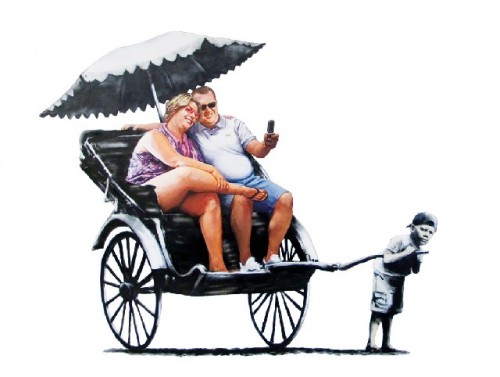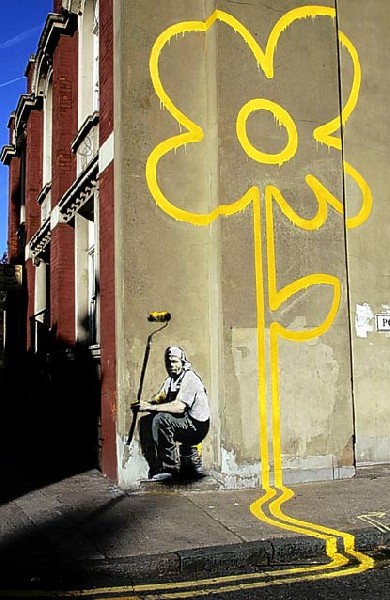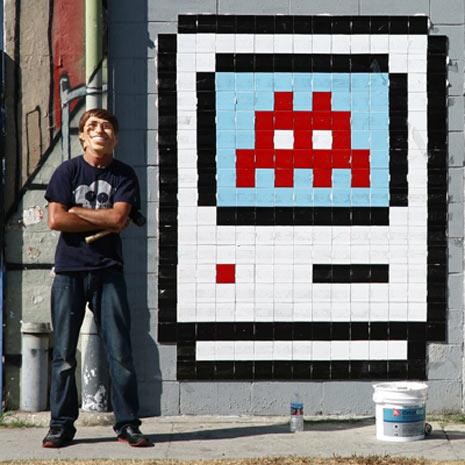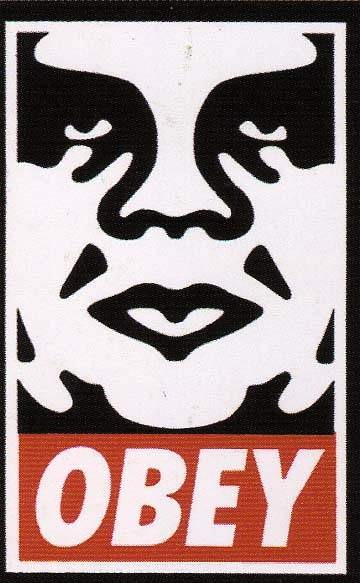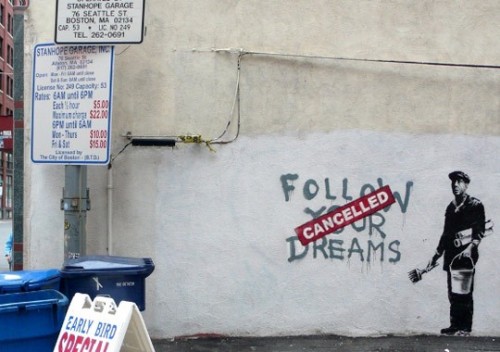Exit Through The Gift Shop Reels Art
World's First Street Art Disaster Movie
By: Mark Favermann - Apr 23, 2010
Graffiti has been around since before the cave paintings. The Ancient Greeks had it as did the Romans. The word "graffiti" means words or drawings scratched or scribbled on a wall. It comes from the Greek term "graphein" (to write) and "grafitti" itself is the plural of the Italian word "graffito." In the HBO miniseries Rome, graffitti was integral to telling the political and sexual story of the leaders of Rome. Graffiti was used as the opening credits. It has been used for centuries as a revolutionary or counter-cultural way of verbal and sometimes figuratively graphic expression.
During WWII, the rather ubiquitous three word scrall, Killroy Was Here, met soldiers throughout Europe. IRA and other rebels wrote slogans and sometimes symbols on walls. It wasn't until the late 1960s that graffiti became an urban visual statement. It first appeared in Philadelphia but quickly spread to New York City. It eventually went global.
"Tagging" was at first primitive, but the individual signatures of the graffiti artists became stronger and visually clearer. It was urban vandalism vs. personal expression and public statement. It was a visible reaction to them, the Establishment, by us, the rebel, the individual, the everyman. To most it was a messy disruption of the urban landscape; to a few there was a disturbing visual quality of self-expression.
The early NYC graffiti late 1960s stars were Julio 204 and Taki 183. They are credited with developing the New York Style on buildings in alleys and on subway trains. This drove patrician Mayor John Linsey nuts. Later trained artists began to use walls, alleys and even billboards as their personal and free galleries or appropriate aspects of graffitti in their canvases. Keith Haring and Jean-Michel Basquait were two of the most prominent. Haring's pop art graphic image work went from seedy urban wall to glittering gallery spaces, museums and even retail applications. Basquait's went from the street to a Neo-Expressionist genre affixed to oversized canvases which were bought by wealthy art collectors. Graffiti was now an art form not just vandalism.
Even star writer and cultural commentator Norman Mailer was taken with graffiti. In his 1974 "The Faith of Graffiti," Mailer gave structure and cultural meaning to paint can spraying. He wrote, "What a quintessential marriage of cool and style to write your name in giant separate living letters, large as animals, lithe as snakes, mysterious as Arabic and Chinese curls of alphabet." Over time, there have arisen artists who have come from a sensibility of street cred or personal street involvement and innate artistic entrepreneurship. They are now referred to as street artists.
The techniques that are used include LED art, mosaic tiling, murals, stencil art, sticker art, posters, street installations, wheatpasting, woodblocking, video projection, and yarn bombing. Among the most prominent are Americans Shepherd Fairey and Ron English, Space Invader from Paris, Blu from Bologna, Italy, the artist collective Faile from New York, JR from Paris, Nunca and Os Gemeos, both from Sao Paulo, Brazil and Sixeart from Barcelona, Spain and the UK's Banksy. There are of course others. Banksy is perhaps the most enigmatic and personally unknown of all. He relishes in his anonymity. The Shadow knows!
Exit Through The Gift Shop is a film produced and ultimately directed by Banksy. The film, a documentary of sorts, was to be about a strange and strange-looking French immigrant Thierry Guetta who kept a video camera attached to his face most of the time. This is supposedly because he had such a terrible and under-documented childhood. Guetta is a vintage clothes shop owner in LA whose advocation was to assist and video document prominent street artists. His cousin is the French (mai oui) street artist who works in tiles, Space Invader. He collected the artists like a butterfly collection.
Oddly, his lovely wife and children go on without him and don't seem to be affected by his trips, nocturnal foraging and general obsession with street artists documenting their activities. Yet, the most elusive street artist escaped him, Banksy. Hardly anyone knows what Banksy looks like. Banksy is also the most mysterious and one of the most prolific street art practitioners in the world. Cousin Space Invader could not or would not assist him in finding Banksy. Then one day, Thierry Guetta receives a call from Shepherd Fairey, yes that Shepherd Fairey, that someone wants Thierry to help him find appropriate walls to enhance and assist him in his work in LA. The person is Banksy. Guetta is overjoyed. He sets out to assist Banksy and be Sancho Panza to Banksy's Don Quixote.
Banksy appears in a black hoody that covers his face and his voice is altered each time he speaks. Banksy and his posse get more and more confused by Guetta's presence. He does not fit in, and he bothers them. After awhile, Thierry is so obnoxious that Banksy turns the tables on him and demands that Guetta do the art and Banksy document him. What transpires during the rest of the movie is the inauguration of Thierry Guetta as an art star, making literally millions of dollars on his rather mediocre derivative oh so trendy art primarily created by unknown others. Thus, the film and the story is actually about the vacuousness and silliness of the art world, not about Banksy. This film becomes Banksy's art and culture statement, a fuzzy, eccentric reflection of his persona and attitude. Standing in for Banksy, Thierry Guetta is the out of place foreigner with no art training, no real formal creative structure and no real artistic or aesthetic rhyme or reason. But, is he really Banksy or just Banksy's notion of the art world?
By this Banksy is looking at the meaning behind the preciousness and power of the art, its superficiality, and sense of reality. This is brilliant filmmaking about an art world and popular culture with a shaky true north. Thierry Guetta's rise underscores this apparently tortured sense of present day society and contemporary culture. Like his clever and provocative art pieces, Banksy renders this by a thoughtfully drawn but strangely "scripted documentary." The reels are just not quite real.
Playing with words, images and the art world, Banksy is actually saying through this film that he is "tagging" us last. But, who is "it"? We are all "it."
The film is 127 minutes long. It is in limited release around the United States.



